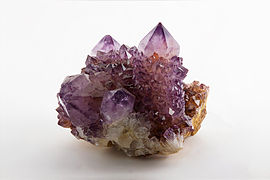Amethyst
| Amethyst | |
|---|---|

Amethyst cluster from Magaliesburg, South Africa.
|
|
| General | |
| Category | oxide mineral |
|
Formula (repeating unit) |
Silica (silicon dioxide, SiO2) |
| Crystal system | Trigonal |
| Crystal class | Trapezohedral (32) |
| Identification | |
| Color | Purple, violet |
| Crystal habit | 6-sided prism ending in 6-sided pyramid (typical) |
| Twinning | Dauphine law, Brazil law, and Japan law |
| Cleavage | None |
| Fracture | Conchoidal |
| Mohs scale hardness | 7–lower in impure varieties |
| Luster | Vitreous/glossy |
| Streak | White |
| Diaphaneity | Transparent to translucent |
| Specific gravity | 2.65 constant; variable in impure varieties |
| Optical properties | Uniaxial (+) |
| Refractive index | nω = 1.543–1.553 nε = 1.552–1.554 |
| Birefringence | +0.009 (B-G interval) |
| Pleochroism | None |
| Melting point | 1650±75 °C |
| Solubility | insoluble in common solvents |
| Other characteristics | Piezoelectric |
Amethyst is a violet variety of quartz often used in jewelry. The name comes from the ancient Greek ἀ a- ("not") and μέθυστος méthystos ("intoxicated"), a reference to the belief that the stone protected its owner from drunkenness. The ancient Greeks wore amethyst and made drinking vessels decorated with it in the belief that it would prevent intoxication. It is one of several forms of quartz. Amethyst is a semiprecious stone and is the traditional birthstone for February.
Amethyst is a purple variety of quartz (SiO2) and owes its violet color to irradiation, iron impurities (in some cases in conjunction with transition element impurities), and the presence of trace elements, which result in complex crystal lattice substitutions. The hardness of the mineral is the same as quartz, thus it is suitable for use in jewelry.
Amethyst occurs in primary hues from a light pinkish violet to a deep purple. Amethyst may exhibit one or both secondary hues, red and blue. The best varieties of amethyst can be found in Siberia, Sri Lanka, Brazil and the far East. The ideal grade is called "Deep Siberian" and has a primary purple hue of around 75–80%, with 15–20% blue and (depending on the light source) red secondary hues. Green quartz is sometimes incorrectly called green amethyst, which is a misnomer and not an appropriate name for the material, the proper terminology being prasiolite. Other names for green quartz are vermarine or lime citrine.
Of very variable intensity, the color of amethyst is often laid out in stripes parallel to the final faces of the crystal. One aspect in the art of lapidary involves correctly cutting the stone to place the color in a way that makes the tone of the finished gem homogeneous. Often, the fact that sometimes only a thin surface layer of violet color is present in the stone or that the color is not homogeneous makes for a difficult cutting.
...
Wikipedia
